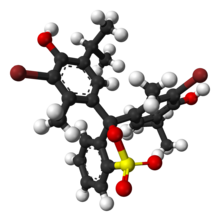
| |

| |
| Names | |
|---|---|
| Preferred IUPAC name
3,3-Bis[3-bromo-4-hydroxy-2-methyl-5-(propan-2-yl)phenyl]-2,1λ6-benzoxathiole-1,1(3H)-dione | |
| Identifiers | |
3D model (JSmol)
|
|
| ChEBI | |
| ChEMBL | |
| ChemSpider | |
| ECHA InfoCard | 100.000.884 |
| EC Number |
|
PubChem CID
|
|
| UNII | |
CompTox Dashboard (EPA)
|
|
| |
| |
| Properties | |
| C27H28Br2O5S | |
| Molar mass | 624.38 g·mol−1 |
| Density | 1.25 g/cm3 |
| Melting point | 202 °C (396 °F; 475 K) |
| Sparingly soluble in water[1] | |
| Acidity (pKa) | 7.0 |
| Hazards | |
| GHS labelling: | |

| |
| Warning | |
| H302, H315, H319 | |
| P264, P270, P280, P301+P312, P302+P352, P305+P351+P338, P321, P330, P332+P313, P337+P313, P362, P501 | |
| NFPA 704 (fire diamond) | |
| Safety data sheet (SDS) | ThermoFisher Scientific |
Except where otherwise noted, data are given for materials in their standard state (at 25 °C [77 °F], 100 kPa).
| |
Bromothymol blue (also known as bromothymol sulfone phthalein and BTB) is a pH indicator. It is mostly used in applications that require measuring substances that would have a relatively neutral pH (near 7). A common use is for measuring the presence of carbonic acid in a liquid. It is typically sold in solid form as the sodium salt of the acid indicator.
- ^ "Archived copy". Archived from the original on 2015-11-26. Retrieved 2015-12-11.
{{cite web}}: CS1 maint: archived copy as title (link)
